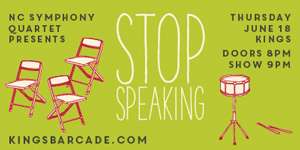On May 2, on the heels of an afternoon concert by the Triangle Youth Philharmonic that ended with Sibelius’ Symphony No. 2, the Raleigh Symphony Orchestra offered a performance of the same work’s finale in Jones Auditorium as a prelude to its annual “Rising Stars” program. For better or worse, it’s rare to hear back-to-back readings of standard fare, and when it happens, comparisons – which can be odious – are inevitable. Both performances were remarkable in their own ways. The large youth orchestra played the score with considerable accuracy and brilliance, although the tempi were somewhat slow. The somewhat smaller RSO, under the firm leadership of Music Director Alan Neilson, took a brisker approach, played with the rock-solid excellence we’ve come to expect from our outstanding community orchestra, and produced a reading that was far more exciting, making one lament that they didn’t do the whole thing. Next time, perhaps.
The reason the RSO trimmed back the Sibelius, which it had apparently planned to give in full, was the unusually good response it received to its annual call for candidates for the “Rising Stars” concert. Neilson explained at the outset that the high quality of this year’s artists – three violinists and three pianists were selected – made narrowing the field much more of a challenge than usual. Indeed, quality of the playing from all was exceptional, making one wish in more than a few cases that the young people had not been limited to single movements (or, in one case, to a single short work). Based on what we heard, our cultural future will be in good hands.
Things got underway with Michiko Theurer performing the finale of Bruch’s Violin Concerto No. 1. The soloist is a sophomore at Greenville’s South Central High School, and she studies with ECU’s Ara Gregorian. Her playing was remarkably fine, and the orchestra gave her excellent support. Analise Denise Kukelhan, who studies with the Ciompi Quartet’s Eric Pritchard and who is a junior at Enloe High School (and the former concertmaster of the TYP), played the substantial first movement of Tchaikovsky’s Concerto with great skill and considerable physical restraint, allowing her listeners to savor the music fully. The violin section of the concert ended with Abigail Albaugh’s refreshing performance of the opening movement of Prokofiev’s Second Concerto. She is a senior at ECU, and she was the evening’s second Gregorian student. Neilson had mentioned that with six soloists, there was somewhat less time to prepare than has been the case in the past, and there was some evidence of this in the orchestral portion of the Prokofiev, but the overall effect was altogether positive.
Following the intermission came three pianists, who used Meredith’s Baldwin grand. Sreeniker Ram, a sophomore at East Chapel Hill High School who studies with UNC’s Thomas Otten, played the big first movement of the Grieg Concerto. Here as elsewhere Neilson proved the ideal accompanist, supporting but never swamping his guest artist and for the most part ensuring close coordination of his players with the soloist. Audrey Low, a home-schooled 11-grade prizewinner from Raleigh whose teacher is John Ruggero, performed the opening movement of Rachmaninov’s Second Concerto with remarkable skill, dexterity, and power. Last but hardly least, UNC senior Alan Rudell, a student of Mayron Tsong, played Prokofiev’s concise First Piano Concerto, a wonderful and consistently engaging work that was realized with wonderful and consistently engaging artistry, although the accompaniment left a bit to be desired.
There were some problems with the low-budget program. The orchestra personnel list was in almost microscopic type, making it virtually impossible to read in the half-light in the hall (or, for that matter, in the full light of day!). And the notes for the Rachmaninov Concerto movement seem to have been taken from a write-up of the premiere of the composer’s First Symphony.
At the end, Benjamin Kilgore Gibbs, the long-term sponsor of these concerts made brief remarks and presented plaques to the soloists. He deserves kudos for backing these annual concerts for thirteen years. But there’s plenty of praise to go around. Neilson is a wonderful concerto leader. The orchestra seems to relish these concerts; its members can surely remember their own ensemble debuts. Over time, these programs have provided the very first opportunities for many young artists to perform with a real orchestra. For some of the youngsters’ friends and perhaps family members, too, these have been their first orchestral concerts. The benefits of such programs thus have long-term effects, whether or not any given youngster makes music his or her career. Even the format has its points: if the soloist is good, one laments that whole works are not given. If not, then a single movement is sometimes sufficient…. And last but hardly least, the fact that the ROS includes these “Rising Stars” programs in its main subscription series is a big plus – this is preferable to shunting such things into kiddie concerts or what-have-you that regular patrons are less likely to attend.











